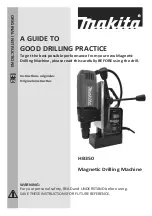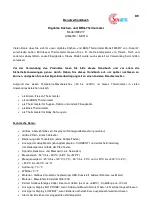
5
DO NOT USE A FLAME TO LEAK TEST.
LEAK TESTING: Although all gas connections on your gas grill are thoroughly leak tested at the factory, a leak test must be
done before initial use, annually and whenever any gas components are replaced or serviced. If the smell of gas is detected at
anytime you should immediately check the entire system for leaks. No smoking while performing this test, and remove all
sources of ignition.
1. Turn all burner controls to off. Turn supply valve on.
2. Brush a half and half solution of liquid soap and water onto all joints and connections of the regulator, hose, manifolds and
valves.
3. Bubbles will indicate a gas leak. Either tighten the loose joint or replace the part with one recommended by the dealer.
4. If the leak cannot be stopped, shut off the gas supply, disconnect it and have the barbecue inspected by your gas supplier
or dealer. Do not use the appliance until the leak has been corrected.
5. Turn off gas supply.
CYLINDER CONNECTION: Ensure that the gas regulator hose is kink free. Inspect the valve connections, port and regulator
assembly for debris or damage. Never attempt to use damaged or obstructed equipment, see your dealer to purchase a
replacement or repairs. Remove the cap or plug from the cylinder fuel valve. Insert the black QCC1 regulator nipple onto the
QCC1 fuel valve. Hand tighten clockwise.
Do not use tools. Use of a wrench may damage the quick coupling nut and result
in an improper connection. Leak test all joints prior to using the barbecue. A leak test must be performed annually, each
time a cylinder is hooked up, or if a part of the gas system is replaced.
PROPANE CYLINDER INSTALLATION: Set cylinder into hole in bottom shelf.
IMPORTANT: The regulator must be attached so that no part of the hose touches the underside of the grill or drippan. A
fire will result if these directions are ignored.
NATURAL GAS HOOK-UP: This natural gas grill is supplied with a 10ft supply hose (complete with a quick disconnect)
designed for natural gas and certified for outdoor use. The gas grill is designed to operate at an inlet pressure of 7 inches
water column. Longer gas lines leading to the gas grill can cause a loss of pressure, resulting in lower operating
temperature. Piping and valves upstream of the quick disconnect are not supplied.
The quick disconnect must not be installed in an upward direction and a readily accessible manual shut-off valve must be
installed upstream of, and as close to, the quick disconnect as is feasible. The flared end of the hose must be connected to
the fitting on the end of the manifold tube as illustrated in the
Natural Gas Hose Attachment diagram. Wrench tighten. (Do not
use thread sealer/pipe dope.) These connections must be made by a licensed gas installer. Leak test all joints prior to using
the gas grill.
IMPORTANT: The gas valves and orifices are different for propane and natural gas. Do not attempt to convert from one
to another.
LEAK TESTING INSTRUCTIONS
GAS HOOK-UP INSTRUCTIONS






































